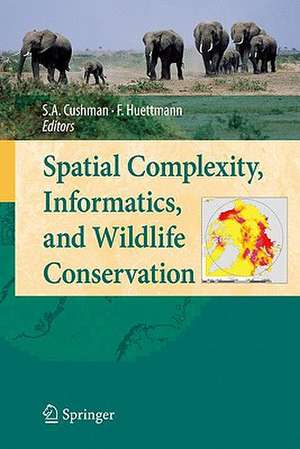Spatial Complexity, Informatics, and Wildlife Conservation
Editat de Samuel A. Cushman, Falk Huettmannen Limba Engleză Hardback – 14 ian 2010
| Toate formatele și edițiile | Preț | Express |
|---|---|---|
| Paperback (1) | 952.72 lei 43-57 zile | |
| Springer – 31 oct 2014 | 952.72 lei 43-57 zile | |
| Hardback (1) | 1397.19 lei 43-57 zile | |
| Springer – 14 ian 2010 | 1397.19 lei 43-57 zile |
Preț: 1397.19 lei
Preț vechi: 1703.90 lei
-18% Nou
Puncte Express: 2096
Preț estimativ în valută:
267.35€ • 279.88$ • 221.22£
267.35€ • 279.88$ • 221.22£
Carte tipărită la comandă
Livrare economică 07-21 aprilie
Preluare comenzi: 021 569.72.76
Specificații
ISBN-13: 9784431877707
ISBN-10: 4431877703
Pagini: 472
Ilustrații: XI, 458 p.
Dimensiuni: 155 x 235 x 31 mm
Greutate: 0.91 kg
Ediția:2010
Editura: Springer
Colecția Springer
Locul publicării:Tokyo, Japan
ISBN-10: 4431877703
Pagini: 472
Ilustrații: XI, 458 p.
Dimensiuni: 155 x 235 x 31 mm
Greutate: 0.91 kg
Ediția:2010
Editura: Springer
Colecția Springer
Locul publicării:Tokyo, Japan
Public țintă
Professional/practitionerDescriere
As Earth faces the greatest mass extinction in 65 million years, the present is a moment of tremendous foment and emergence in ecological science. With leaps in advances in ecological research and the technical tools available, scientists face the critical task of challenging policymakers and the public to recognize the urgency of our global crisis. This book focuses directly on the interplay between theory, data, and analytical methodology in the rapidly evolving fields of animal ecology, conservation, and management. The mixture of topics of particular current relevance includes landscape ecology, remote sensing, spatial modeling, geostatistics, genomics, and ecological informatics. The greatest interest to the practicing scientist and graduate student will be the synthesis and integration of these topics to provide a composite view of the emerging field of spatial ecological informatics and its applications in research and management.
Cuprins
Preface Part I Theory and Practice 1 Introduction: Ecological Knowledge, Theory and Information in Space and Time Samuel A. Cushman and Falk Huettmann 2 Space and Time in Ecology: Noise or Fundamental Driver? Samuel A. Cushman 3 The Problem of Ecological Scaling in Spatially Complex, Nonequilibrium Ecological Systems Samuel A. Cushman, Jeremy Littell, and Kevin McGarigal 4 Landscape Ecology: Past, Present, and Future Samuel A. Cushman, Jeffery S. Evans, and Kevin McGarigal 5 The Gradient Paradigm: A Conceptual and Analytical Framework for Landscape Ecology Samuel A. Cushman, Kevin Gutzweiler, Jeffrey S. Evans, and Kevin McGarigal Part II Method and Data 6 Data on Distribution and Abundance: Monitoring for Research and Management Samuel A. Cushman and Kevin S. McKelvey 7 Animal Movement Data: GPS Telemetry, Autocorrelation and the Need for Path-Level Analysis Samuel A. Cushman 8 Using a Random Forest Model and Public Data to Predict the Distribution of Prey for Marine Wildlife Management Steffen Oppel and Falk Huettmann 9 Landscape Genomics: A Brief Perspective Michael K. Schwartz, Gordon Luikart, Kevin S. McKelvey,and Samuel A. Cushman 10 Spatial Information Management in Wildlife Ecology: Adding Spatially Explicit Behaviour Data to the Equation? Kim Jochum and Falk Huettmann 11 Critical Remote Sensing Contributions to Spatial Wildlife Ecological Knowledge and Management Gregory J. McDermid, Nicholas C. Coops, Michael A. Wulder, Steven E. Franklin, and Nicole E. Seitz 12 Spatial Data Management Through Metadata: Global Concepts, Formats, Tools and Requirements Vivian Hutchison 13 Free Database Availability, Metadata and the Internet: An Example of Two High Latitude Components of the Census of Marine Life Bodil Bluhm, David Watts, and Falk Huettmann 14 Components of Spatial Information Management in Wildlife Ecology: Software for Statistical and Modeling Analysis Hawthorne L. Beyer, Jeff Jenness, and Samuel A. Cushman 15 Spatial Analysis of Wildlife Distribution and Disease Spread Marie-Josee Fortin, Mark R.T. Dale, and Stefania Bertazzon 16 Current State of the Art for Statistical Modelling of Species Distributions Troy M. Hegel, Samuel A. Cushman, Jeffery Evans, and Falk Huettmann 17 Landscape Genetics Kevin S. McKelvey, Samuel A. Cushman, and Michael K. Schwartz Part III Examples 18 Using Geographical Mapping and Occupancy Modeling to Study the Distribution of the Critically Endangered Leopard (Panthera pardus) Population in Armenia Igor G. Khorozyan, Alexander G. Malkhasyan, Shushanik G. Asmaryan, and Alexei V. Abramov 19 Mapping Landscape Resistance to Identify Corridors and Barriers for Elephant Movement in Southern Africa Samuel A. Cushman, Michael Chase, and Curtice Griffin 20 Habitat Fragmentation Effects Depend on Complex Interactions Between Population Size and Dispersal Ability: Modeling Influences of Roads, Agriculture and Residential Development Across a Range of Life-History Characteristics Samuel A. Cushman, Bradley W. Compton, and Kevin McGarigal 21 Linking Cetaceans to Their Environment: Spatial Data Acquisition, Digital Processing and Predictive Modeling for Marine Spatial Planning in the Northwest Atlantic Simon J. Pittman and Bryan Costa 22 Multi-spectral Satellite-Airborne Management of Ice Form Marine Mammals and Their Habitat in the Presence of Climate Change Using a 'Hot Spots' Approach Vladimir V. Melentyev and Vladimir I. Chernook 23 How Spatial Information Contributes to the Conservation and Managemen
Recenzii
From the reviews:
“Spatial complexity, informatics, and wildlife conservation was based on the symposium ‘Advanced GeoScience Applications’ held at the 9th International Mammalogical Conference in Hokkaido, Japan in 2005. … the intended audience would include researchers, scientists and graduate level students. … this book more valuable to have available in libraries, university departments or labs … . I recommend practitioners of spatial data and their analysis read this book to extract what valuable information they can.” (Stephen L. Webb, Ecology, Vol. 91 (12), December, 2010)
“Spatial complexity, informatics, and wildlife conservation was based on the symposium ‘Advanced GeoScience Applications’ held at the 9th International Mammalogical Conference in Hokkaido, Japan in 2005. … the intended audience would include researchers, scientists and graduate level students. … this book more valuable to have available in libraries, university departments or labs … . I recommend practitioners of spatial data and their analysis read this book to extract what valuable information they can.” (Stephen L. Webb, Ecology, Vol. 91 (12), December, 2010)
Caracteristici
Includes supplementary material: sn.pub/extras














